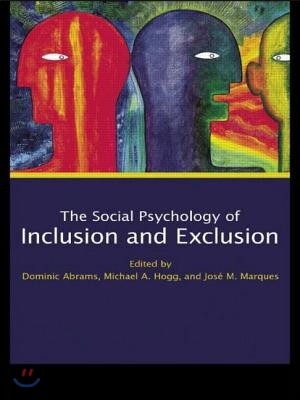
Social Psychology of Inclusion and Exclusion
- 발행사항
- New York: Psychology Press, 2005
- 형태사항
- xviii, 355 p. : ill. ; 24 cm
- ISBN
- 9780415651813
- 청구기호
- 305 A161s
- 서지주기
- Includes bibliographical references and indexes
소장정보
| 위치 | 등록번호 | 청구기호 / 출력 | 상태 | 반납예정일 |
|---|---|---|---|---|
지금 이용 불가 (1) | ||||
| 1자료실 | 00020198 | 대출중 | 2025.07.31 | |
- 등록번호
- 00020198
- 상태/반납예정일
- 대출중
- 2025.07.31
- 위치/청구기호(출력)
- 1자료실
책 소개
목차
AcknowledgementsContributorsChapter 1. A Social Psychological Framework for Understanding Social Inclusion and ExclusionDominic Abrams, Michael A. Hogg and José M. MarquesSECTION A: INDIVIDUAL INCLUSION AND EXCLUSIONChapter 2. Social Exclusion Increases Aggression and Self-defeating Behavior while Reducing Intelligent Thought and Prosocial BehaviorJean M. Twenge and Roy F. BaumeisterChapter 3. Reacting to Ostracism: Retaliation or Reconciliation?Kipling D. Williams and Cassandra L. GovanChapter 4. Stigma and Social ExclusionBrenda Major and Collette P. EcclestonChapter 5. The Role of Exclusion in Maintaining Ingroup InclusionCynthia L. Pickett and Marilynn B. BrewerChapter 6. Exclusion of the Self by Close Others and by Groups: Implications of the Self-Expansion ModelTracy McGlaughlin-Volpe, Art Aron, Stephen C. Wright and Gary W. Lewandowski Jr.SECTION B: GROUP DYNAMICS OF INCLUSION AND EXCLUSIONChapter 7. Managing Group Composition: Inclusive and Exclusive Role TransitionsJohn M. Levine, Richard L. Moreland, and Leslie R. M. HausmannChapter 8. When Bad Becomes Good (and Vice Versa): Why Social Exclusion Is Not Based on DifferenceDominic Abrams, Georgina Randsley de Moura, Paul Hutchison and G.Tendayi VikiChapter 9. Fringe Dwellers: Processes of Deviance and Marginalization in Groups Michael A. Hogg and Kelly S. Fielding and John DarleyChapter 10. Delinquency: Cause or consequence of social exclusion?Nicholas Emler and Stephen ReicherSECTION C: INTERGROUP INCLUSION AND EXCLUSIONChapter 11. Social Inclusion and Exclusion: Recategorization and the Perception of Intergroup BoundariesJohn F. Dovidio, Samuel L. Gaertner, Gordon Hodson, Melissa A. Houlette and Kelly M. JohnsonChapter 12. Intergroup Contact in a Divided Society: Challenging Segregation in Northern IrelandMiles Hewstone, Ed Cairns, Alberto Voci, Stefania Paolini, Frances McLernon, Richard J. Crisp, Ulrike, Niens and Jean CraigChapter 13. Cognitive Representations and Exclusion of Immigrants: Why Red-Nosed Reindeer Don't Play GamesDiana R. Rice and Brian MullenChapter 14. Attitudes toward Immigrants and Immigration: The Role of National and International IdentityVictoria M. Esses, John F. Dovidio, Antoinette Semenya and Lynne M. JacksonAuthor IndexSubject Index
